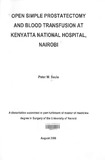Open simple prostatectomy and blood transfusion at Kenyatta National Hospital, Nairobi
Abstract
Background
Open simple prostatectomy has long been associated with large blood losses; hence
allogeneic blood transfusion in this procedure is a standard practice world over. A review of
literature suggests significant association between peri-operative blood loss accompanying
open simple prostatectomy and certain patient factors18.19.2o.21.22.23.While blood transfusion rate
in open simple prostatectomy had been widely investigated in other centres11.12.17.25,this
seemed not to be the case at Kenyatta National Hospital. The shortage of blood and blood
products in our blood transfusion centres as well as the alarming risks of transfusion reactions
and disease dissemination demanded a review of these factors with the aim of reducing
morbidity associated with peri-operative blood loss and blood transfusion28.29.3o.
Objectives
To assess blood loss, determine blood transfusion rate, and define some of the factors
associated with peri-operative blood loss and blood transfusion in open simple prostatectomy.
Methodology
A prospective cohort study was conducted in the urology units of Kenyatta National Hospital,
Kenya, between June 2004 and May 2005. Ninety-five patients who were admitted with a
clinical diagnosis of benign prostatic hyperplasia and underwent open simple prostatectomy
were enrolled into the study upon giving a written informed consent. Data on the study
variables including the patients' age, pre-operative medication, clinical presentation, preoperative
systolic blood pressure, American Society of Anaesthesiologists (ASA) grade, preand
post- operative. haemoglobin levels, technique of anaesthesia, technique of open simple
prostatectomy, weight of resected prostatic tissue, blood loss estimation, units of blood
transfused, and the duration of hospital stay was collected and analysed. The peri-operative
blood loss was judged from the mean decrease in peri-operative haemoglobin concentration.
The mean decrease in haemoglobin was derived from the pre- and post-operative
haemoglobin. The post-operative haemoglobin for the patients transfused peri-operatively was
corrected for the transfused volume by subtracting 19/dl for each transfused unit of blood".
The main study outcome was defined as the mean decrease in peri-operative haemoglobin and
blood transfusion rate.
Results
Ninety-five patients who underwent open simple prostatectomy for benign prostatic hyperplasia
were enrolled into the study. Their median age was 70 years (Range 50 to 97). The mean
decrease in haemoglobin concentration, which was the main indicator of peri-operative blood
loss, was 2.1g/dl (± 1.4). The peri-operative blood transfusion rate was 36.8%. Twenty-four
(68.6%) of the patients who received either 1 or 2 units of blood had a pre-operative
haemoglobin level above 13.5g/dl and a post-operative haemoglobin level above 11.5g/dl,
while 11 (31.4%) had severe peri-operative bleeding, that necessitated immediate surgical reintervention.
A total of 68 units of blood was transfused, 42 (61.8%) allogeneic and 26 (38.2%)
autollogous blood.
The post-operative median hospitalisation time was 8 days (Range 4 to 35). There were 2
(2.1%) post-operative deaths and both patients had intractable intra- and post-operative
bleeding, massive blood transfusion and disseminated intravascular coagulopathy.
The factors that were significantly associated with peri-operative blood loss and blood
transfusion in open simple prostatectomy were patient's age above 70 years, pre-operative use
of acetyl-salicylate or warfarin sodium, pre-operative systolic blood pressure above 140mmHg,
general anaesthesia, Freyer's (transvesical) technique and the weight of resected prostatic
tissue above 70g.
Conclusion
Open simple prostatectomy performed under spinal anaesthesia using Millin's (retropubic)
technique is associated with minimal blood loss. The peri-operative blood transfusion rate was
36.8% and most of the blood transfusion was clinically unjustified. Transfusion of autollogous
blood in open simple prostatectomy was underutilized at Kenyatta National Hospital.
Citation
M.Med (Surgery) ThesisSponsorhip
University of NairobiPublisher
Department of Medicine, University of Nairobi
Description
Master of Medicine

